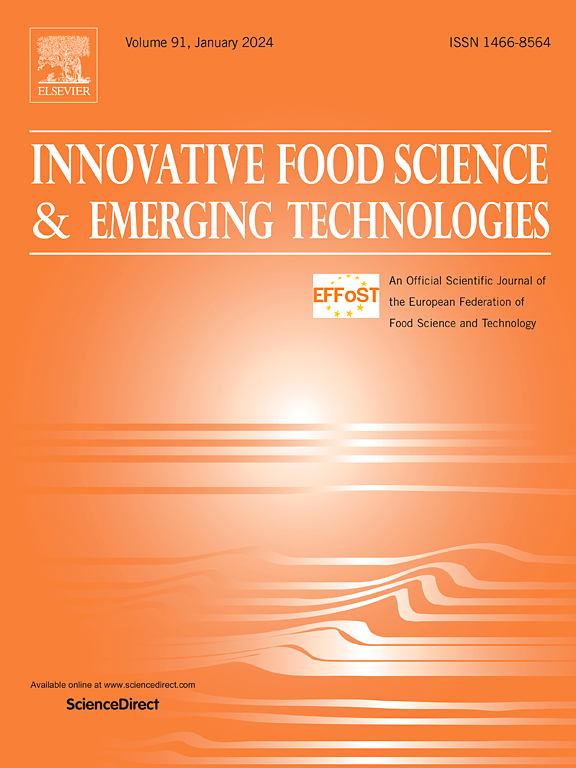草药康普茶醋:生物技术前景、生物学潜力和感官评价
IF 6.3
1区 农林科学
Q1 FOOD SCIENCE & TECHNOLOGY
Innovative Food Science & Emerging Technologies
Pub Date : 2025-02-10
DOI:10.1016/j.ifset.2025.103955
引用次数: 0
摘要
消费者对天然和有机产品的偏好日益增加,以及对醋的多功能和健康益处的认识,是全球醋市场增长的关键驱动因素。这种不断增长的需求给了醋生产商一个很好的机会,使他们的产品多样化。在本研究中,研究了在蔗糖糖红茶和不同草药(薄荷、洋甘菊、荨麻、百里香、紫雏菊、柠檬香蜂草、蓍草、薰衣草、罗勒和缬草)的基础上,通过本地细菌和酵母共生培养的长期发酵,生产康普茶醋的可能性。通过对发酵培养基的生物工艺成功指标进行分析,确定了使用过的康普茶培养基在应用条件下的发酵能力。根据所得产品的化学成分、生物活性和感官特性对其质量进行了评价。对所有实验数据进行统计学处理,以确定培养基成分变化对康普茶延长发酵效果的影响。综上所述,罗勒作为最具利用潜力的中草药,被选为康普茶食醋的生产原料。康普茶食醋是一种具有保健作用的创新食品。本研究制备的罗勒基康普茶产品是一种富含营养物质和生物活性物质的酸性产品(pH值为2.66)(糖含量为32.78 g/L,总酸含量为55.52 g/L,总酚含量为29.32 mg GAE/L,维生素C含量为3.85 mg/L, RSCDPPH含量为85.59%,RSCABTS含量为58.89%),具有良好的感官质量(评价感官属性的平均喜欢分数≥8.3)。本文章由计算机程序翻译,如有差异,请以英文原文为准。
Herbal kombucha vinegar: Biotechnological perspective, biological potential and sensory evaluation
Increasing consumer preference for natural and organic products, along with recognition of the multifunctionality and health benefits of vinegar, are key drivers of the global vinegar market growth. This growing demand gives vinegar producers a great opportunity to diversify their product offerings. In this study, the possibility of kombucha vinegar production on sucrose-sweetened black tea and infusions based on different herbs (peppermint, chamomile, stinging nettle, thyme, echinacea, lemon balm, yarrow, lavender, basil, and valerian) through prolonged fermentation by the autochthonous symbiotic culture of bacteria and yeasts was examined. The fermented media were analyzed regarding bioprocess success indicators to determine the fermentation capability of the used kombucha culture under the applied conditions. The quality of the obtained products was evaluated based on their chemical composition, bioactivity, and sensory properties. All experimental data were statistically processed to establish the effect of the medium composition variation on the prolonged kombucha fermentation efficacy. Summarizing all the results and findings, the basil was selected as the herb with the greatest utilization potential in the production of herbal kombucha vinegar, an innovative food product with promising health-promoting effects. The basil-based kombucha product created in this study is an acidic product (pH value of 2.66) rich in nutrients and bioactive compounds (sugars content of 32.78 g/L, total acids content of 55.52 g/L, total phenols content of 29.32 mg GAE/L, vitamin C content of 3.85 mg/L, RSCDPPH of 85.59 %, and RSCABTS of 58.89 %), and with highly acceptable sensory quality (mean liking scores for the evaluated sensory attributes ≥8.3).
求助全文
通过发布文献求助,成功后即可免费获取论文全文。
去求助
来源期刊
CiteScore
12.00
自引率
6.10%
发文量
259
审稿时长
25 days
期刊介绍:
Innovative Food Science and Emerging Technologies (IFSET) aims to provide the highest quality original contributions and few, mainly upon invitation, reviews on and highly innovative developments in food science and emerging food process technologies. The significance of the results either for the science community or for industrial R&D groups must be specified. Papers submitted must be of highest scientific quality and only those advancing current scientific knowledge and understanding or with technical relevance will be considered.

 求助内容:
求助内容: 应助结果提醒方式:
应助结果提醒方式:


